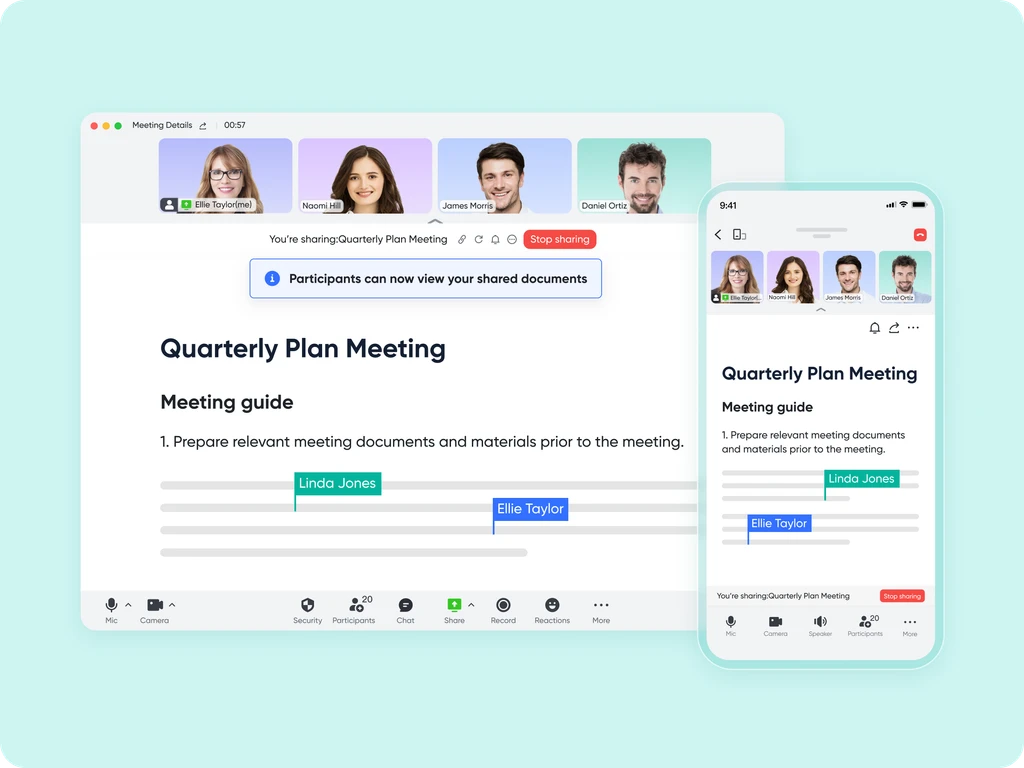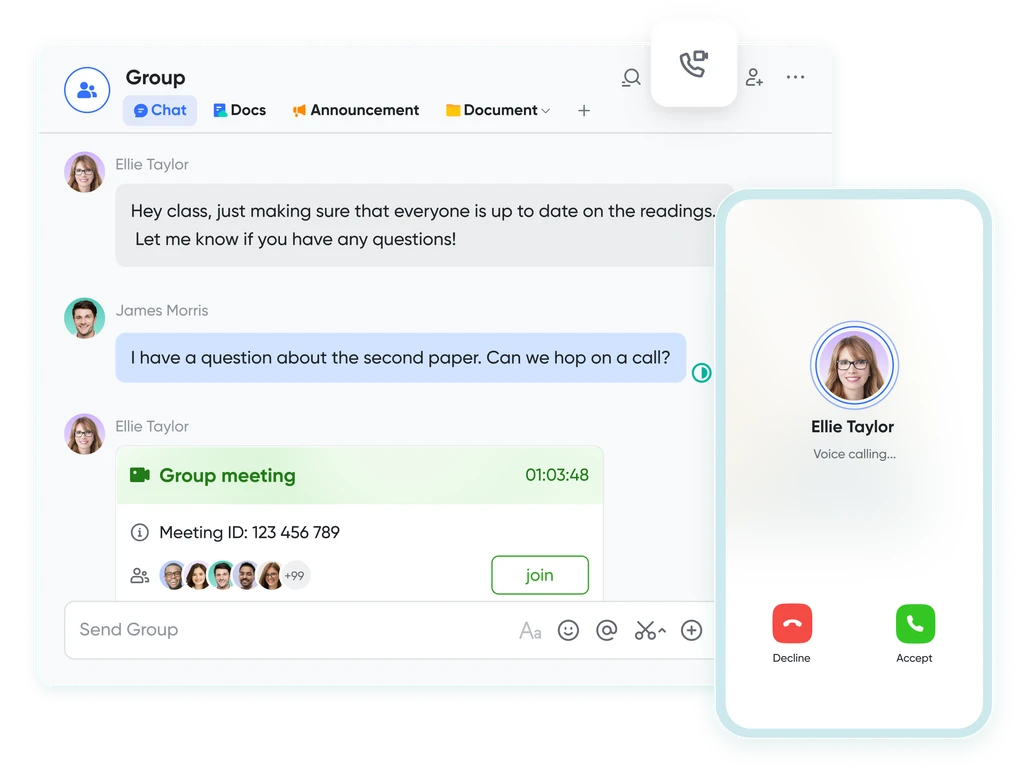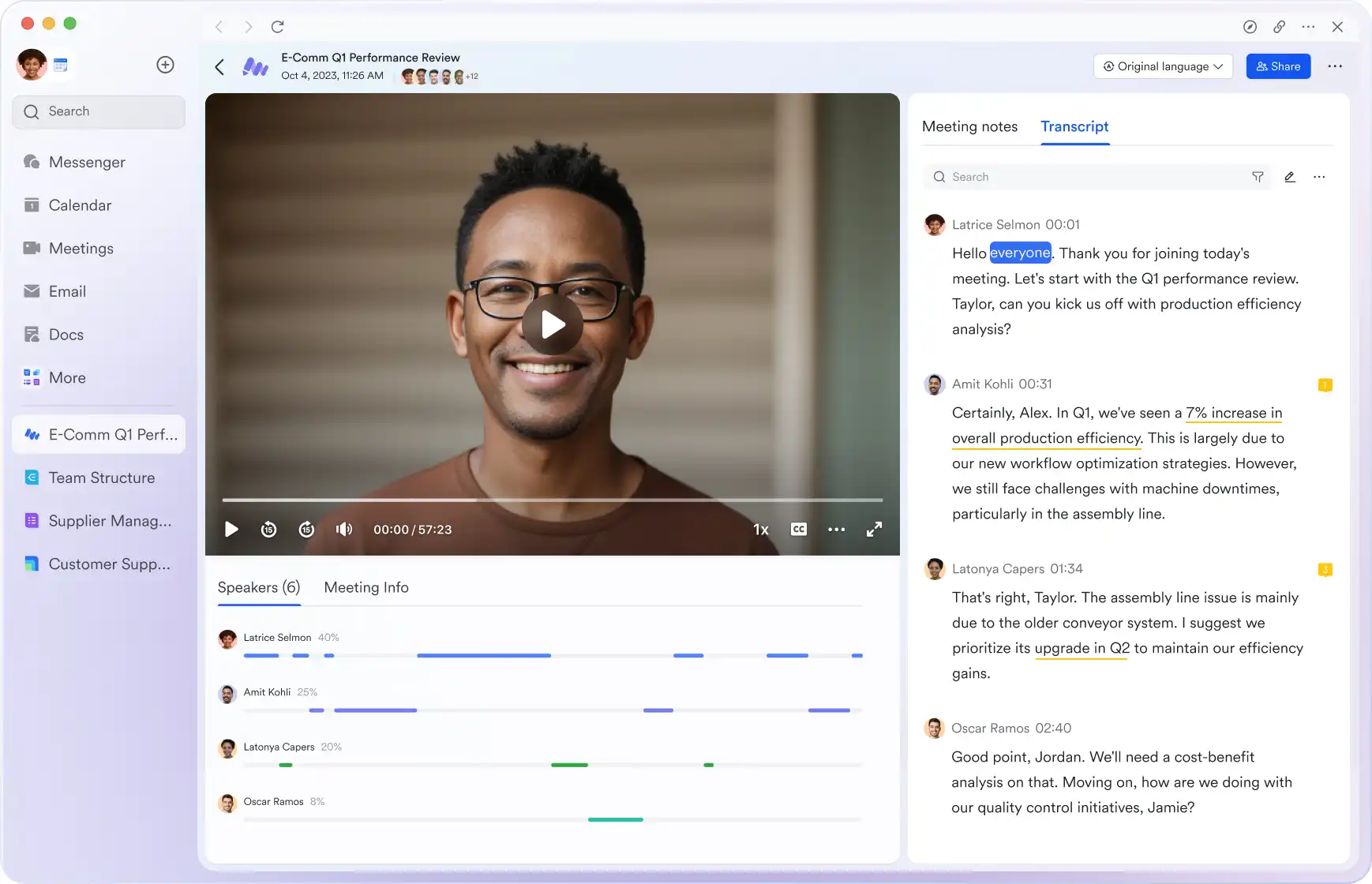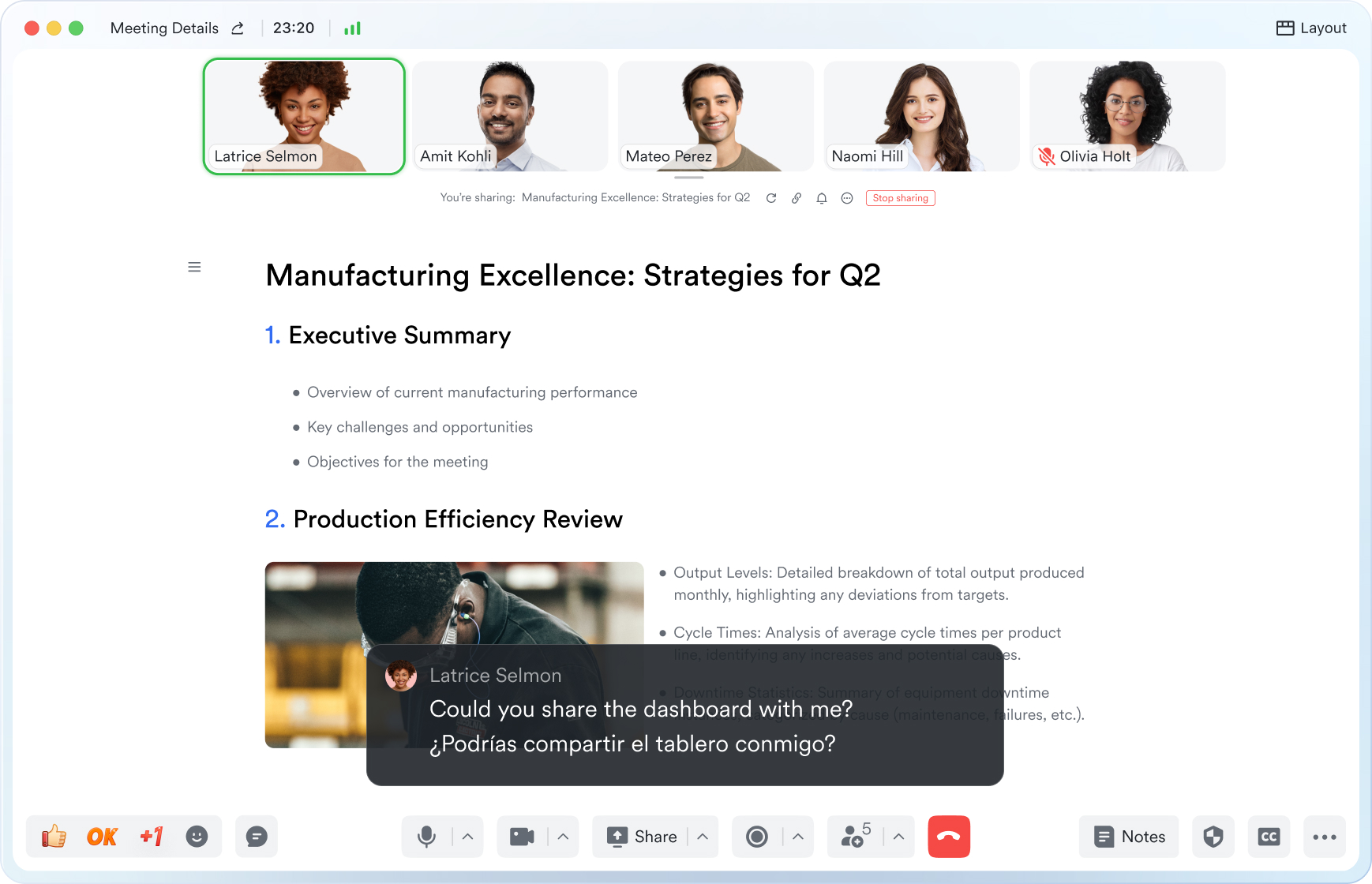Orientation Meeting
This guide will walk you through the essential elements of use orientation meeting to keep your attendees aligned and engaged.
Try Lark for Free
The initial interaction that new employees have with an organization is pivotal in shaping their perception and setting the tone for their journey ahead. A well-structured orientation meeting not only provides clarity but also fosters a sense of belonging and importance within the organizational ecosystem. This guide will outline the essential aspects that define an effective orientation meeting and provide insights into making it a success, especially in the context of the year 2024.
Use Lark Meetings to turn meetings into true collaborative experiences.
What is an orientation meeting?
An orientation meeting, also known as an onboarding session, is the initial formal interaction between new employees and the organization. It serves as an introduction to the company's culture, policies, and procedures, offering an overview of the work environment and expectations.
The primary purpose of an orientation meeting is to equip new employees with essential information, foster a sense of belonging, and lay the groundwork for aligning their performance with the organization's goals.
Goals of orientation meeting
Orientation meetings serve multiple crucial purposes, including:
- Acquainting new hires with the corporate culture and values
- Providing an overview of the organizational structure and their role within it
- Clarifying performance expectations and professional development opportunities
Who should attend orientation meeting?
The audience for an orientation meeting typically includes newly hired employees across all levels, including full-time, part-time, and contract-based positions. Additionally, key stakeholders such as HR representatives, department heads, and team leaders should also participate to effectively communicate the organizational goals, values, and expectations.
Adapting to the remote work scenario, virtual orientation meetings must involve IT support staff to ensure a seamless experience for all participants.
Learn more about Lark x Meetings
Topics, agenda, and structure of orientation meeting
Crafting a Comprehensive Agenda
The agenda of an orientation meeting should be designed to strike a balance between informative sessions and interactive activities, ensuring that the crucial information is imparted without overwhelming the attendees. Topics to include in the agenda:
- Company overview and history
- Organizational structure and teams
- HR policies and employment benefits
- Role-specific training and expectations
- Interactive team-building activities
Structuring Orientation Meeting for Maximum Engagement
Given the diverse backgrounds and learning styles of participants, a multi-modal approach is advised. A mix of presentations, interactive sessions, and Q&A segments ensures engagement and understanding.
Balancing Information Dissemination with Interaction
While sharing critical information is essential, it's equally important to foster an environment where attendees feel comfortable asking questions and engaging in discussions. This helps in clarifying doubts and alleviating any concerns, promoting a sense of inclusivity and open communication from day one.
Learn more about Lark x Meetings
How often does an orientation meeting occur?
The frequency of orientation meetings varies depending on organizational needs and the volume of new hires. Traditionally, these sessions were scheduled monthly or quarterly. However, with the evolving work landscape, particularly the rise of remote work, organizations may opt for more frequent or targeted orientation meetings.
Key difference between orientation meeting and another similar meeting
While orientation meetings are often confused with onboarding sessions and training programs, they have distinct differences:
- Orientation Meeting vs. Onboarding Session: While onboarding encompasses a broader spectrum of organizational integration activities, orientation meetings specifically focus on introducing individuals to the organization's culture, policies, and structure.
- Orientation Meeting vs. Training Programs: Unlike training programs that focus on skill development and job-specific training, orientation meetings lay the foundation for employees to understand the organization's fundamentals and expectations.
Related:
Master the Art of Meeting Notes with Lark for Enhanced Collaboration | Lark Blog | Lark BlogLearn more about Lark x Meetings
Three practical examples of orientation meetings
On-site orientation for small organizations
On-site orientation for small organizations
In a small organization, a personalized and intimate on-site orientation meeting can be highly effective. It allows for comprehensive engagement, individual attention, and seamless facilitation.
Virtual orientation for international teams
Virtual orientation for international teams
In the context of global teams, a virtual orientation meeting leveraging video conferencing and interactive digital tools ensures inclusivity and flexibility while effectively disseminating information across time zones and geographical constraints.
Hybrid orientation for remote and office-based teams
Hybrid orientation for remote and office-based teams
Organizations with a hybrid workforce can opt for a combined on-site and virtual orientation approach. This strategy offers the best of both worlds, providing personal interaction and flexibility for remote employees.
Common pitfalls of an orientation meeting
A poorly executed orientation meeting can result in disengagement, confusion, and dissatisfaction among new hires. Common pitfalls to avoid include:
- Inadequate Preparation: Insufficient planning and coordination can lead to a disjointed and unproductive session.
- Information Overload: Presenting an overwhelming amount of information without opportunities for clarification can be counterproductive.
- Lack of Interaction: Failing to create an interactive and engaging atmosphere can hinder the assimilation of information and the building of connections.
Related:
Unlock the Power of Webinars: A Comprehensive Guide to Boost Your Business | Lark Blog | Lark BlogLearn more about Lark x Meetings
Dos and don’ts of an orientation meeting
| Do's | Don'ts |
|---|---|
| Encourage Interaction | Avoid Monotonous Presentations |
| Personalize Welcome Messages | Overwhelm Attendees with Information |
| Provide Clear Guidelines | Underestimate the Importance of Feedback |
Encouraging active participation, personalizing communication, and maintaining a balanced flow of information are essential strategies in conducting a successful orientation meeting. Conversely, avoiding prolonged one-way presentations and overwhelming attendees is crucial to prevent disengagement and information overload.
What makes a virtual orientation meeting successful?
For a virtual orientation meeting to be successful, certain factors need to be considered:
- Leveraging Technology for Engagement: Utilizing interactive tools and platforms for seamless communication and participation.
- Overcoming Physical Barriers: Ensuring that technical and logistical barriers are adequately addressed to provide a seamless experience for virtual participants.
- Embracing Interactive Tools: Employing engagement tools such as polling, quizzes, and breakout groups to maintain active participation and collaboration.
Learn more about Lark x Meetings
Typical takeaways of the orientation meeting
Upon the conclusion of an orientation meeting, new employees should ideally take away the following:
- Understanding Organizational Culture: A clear comprehension of the company’s values, mission, and workplace culture.
- Clear Expectations and Guidelines: Clarity on performance expectations, organizational policies, and available resources.
- Network Building Opportunities: Opportunities to interact with colleagues, leaders, and essential support personnel, thereby fostering a sense of belonging and social integration.
Questions to ask in the orientation meeting
- Open-Ended Introductions: Fostering introductory sessions that encourage new hires to share their professional background, interests, and expectations from the organization.
- Clarifications on Roles and Responsibilities: Offering a platform for new employees to seek detailed explanations about their roles, team structures, and potential growth opportunities within the organization.
- Opportunities for Feedback and Queries: Encouraging an open forum for questions, concerns, and feedback, ensuring that new hires feel valued and heard from the onset.
Related:
Unlock the Power of Webinars: A Comprehensive Guide to Boost Your Business | Lark Blog | Lark BlogLearn more about Lark x Meetings
Conclusion
In the ever-evolving corporate arena, an effective orientation meeting is vital for stimulating employee engagement, increasing retention rates, and aligning new hires with an organization's pursuits. With the dawn of 2024, the significance of a well-structured and engaging orientation meeting stands as a foundational element of organizational success. By adhering to the best practices outlined in this guide, companies can ensure that orientation meetings serve as catalysts for fostering an empowered and cohesive workforce, thereby contributing to the attainment of their strategic objectives.
Learn more about Lark x Meetings
Use Lark Meetings to turn meetings into true collaborative experiences.
A Game Changer for Orientation Meeting: Empower your team with Lark Meetings
In the fast-paced and dynamic world of modern business, effective communication and collaboration are crucial for success of Orientation Meeting. Here we introduce Lark Meetings to serve as a centralized hub for all communication needs.
Transform your meetings into collaborative endeavors

Leverage the potency of in-call document sharing, intelligent meeting minutes, and mobile-optimized features to enhance productivity collaboratively, irrespective of your location or schedule.
Seamlessly collaborate in real-time, across any device

Share live documents instead of just screen views. Participants can navigate and edit simultaneously within the video call window, even while on the move.
Shift your focus to engagement, not note-taking

Lark Minutes automatically converts video meetings into transcripts, facilitating easy viewing, searching, and collaborative editing. Stay in the loop asynchronously, even if you can't attend the live meeting. Lark Minutes for meeting minutes support translation into 10+ different languages.
Break language barriers in communication

Lark Meetings provide real-time translation for subtitles, allowing individuals from diverse backgrounds to express themselves in their native languages. Ensure every voice is heard, regardless of geographical location. Live subtitles currently support translations from English, Chinese, and Japanese to 10+ different languages. See more translation feature in Lark.
Connect with larger audiences
Host dynamic online meetings and events accommodating up to 1,000 participants, with the flexibility of up to 50 breakout sessions for intimate group discussions within the larger meeting context. Try more Lark features for free.








